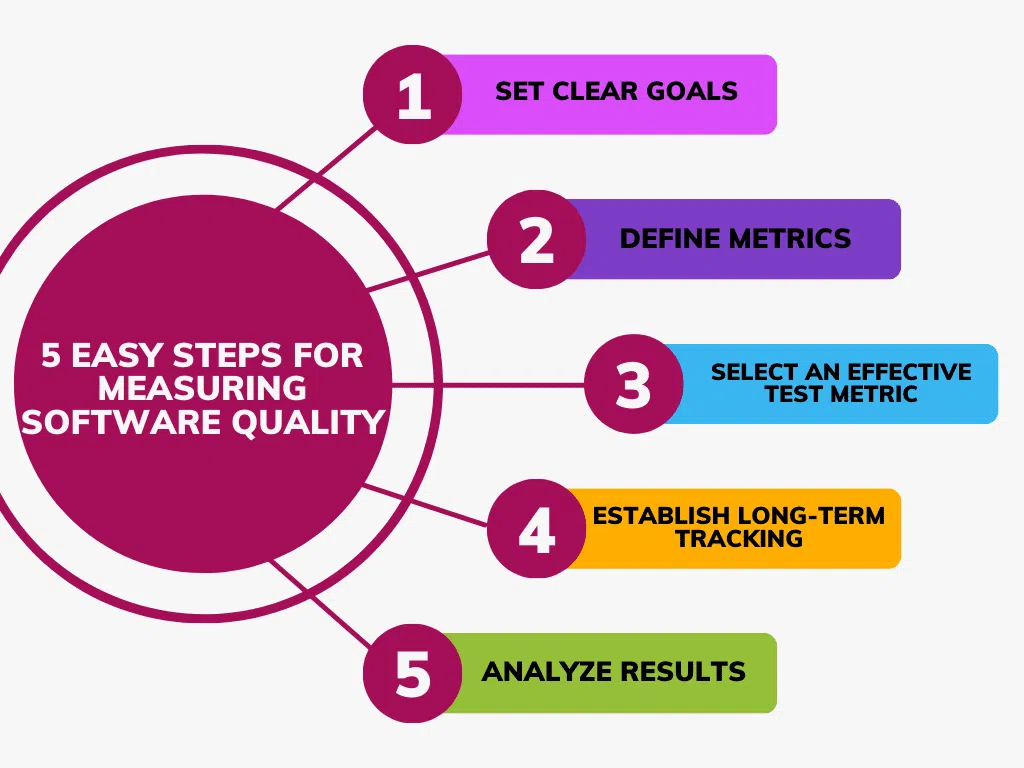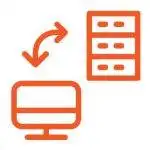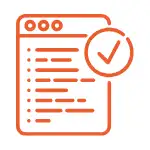Table of Contents
ToggleSoftware quality refers to the degree to which a software product or system meets specified requirements and customer expectations. It encompasses various aspects such as reliability, functionality, performance, usability, maintainability, and security. Measuring software quality is crucial because it directly impacts the overall success of software projects and the satisfaction of end-users.
In the context of custom software development, it is crucial to recognize the paramount importance of delivering high-quality software solutions. This entails implementing robust quality metrics and continuously monitoring for emerging programming errors. Prioritizing software quality over quantity has become the norm, reflecting the industry’s recognition of the significance of providing superior software products. Additionally, actively seeking and incorporating user feedback into the software development process ensures that the software meets the specific requirements and expectations of its intended users.
In this article, we will see a step-by-step approach to measuring software quality with specific quality metrics.
Metrics for Measuring Software Quality
Software quality is assessed using metrics that cover code quality, performance, security, and usability. By measuring software quality at various stages of development, we can ensure the delivery of reliable, efficient, secure, and user-friendly software products to meet the needs and expectations of our clients.
· Code Quality
Code quality metrics assess the technical aspects of the software’s codebase. Quantitative metrics measure code complexity, lines of code, bug density, and more. Qualitative metrics evaluate maintainability, readability, efficiency, clarity, and adherence to coding standards.
· Performance
Performance metrics gauge how effectively the software fulfills its intended purpose. They measure factors such as resource utilization, scalability, response times, and customer satisfaction.
· Security
Software security metrics focus on ensuring the integrity and safety of the software. They assess vulnerability management, resistance to unauthorized changes, and adherence to security standards.
· Usability
Usability metrics evaluate the software’s ease of use and practicality for end-users. They consider factors like user-friendliness, intuitive interfaces, and satisfaction with features and performance.
· Measuring Software Quality Throughout the Development
Software development and Quality Assurance (QA) teams collaborate to ensure high-quality software. Software quality metrics also help in the process. The QA team conducts product testing, but the quality is also maintained and measured throughout development. The specific timing of quality measurement depends on the development methodology used. We employ two methodologies: Waterfall and Agile. Each methodology has its own testing approach, allowing us to test the software at different points during development.
5 Easy Steps for Measuring Software Quality

1. Setting Clear Goals and Aligning Software Quality Measurement
In order to effectively measure software quality, it is imperative to define the goals of your software company. Setting a goal helps the business to evaluate which software quality metrics apply to the product.
Determine whether your focus is on enhancing customer satisfaction, driving sales growth, or maximizing shareholder value. This clear understanding of your objectives will dictate the approach you take in measuring software quality. It is crucial to adhere to a key principle in business, which is to concentrate on areas that directly contribute to profits and growth.
Therefore, before investing significant time and resources in measuring software quality, it is essential to establish the importance of this undertaking. Without a clear connection between these metrics and your business goals, it becomes challenging to justify further investment. By aligning your software quality measurement strategy with the specific areas that drive success in your organization, you can optimize your efforts and ensure that they are directly linked to achieving your desired outcomes.
2. Defining Metrics for Measuring Software Success
After establishing the goals of your software, it is important to determine how to measure the success of your software and ensure its quality. There are several key metrics that can be used for this purpose:
· Productivity
Measure the number of bugs or issues found per unit of software created, typically on a daily or hourly basis. This metric provides insights into the efficiency of the development process and identifies areas that require improvement.
· Test Coverage
Evaluate the extent to which each feature and area in the code base has been tested. Assessing test coverage helps ensure that all critical functionalities have been thoroughly tested, reducing the risk of undiscovered defects.
· User Satisfaction Surveys
Conduct surveys to gather feedback from customers regarding their satisfaction with the software. Determine whether users find the software useful and identify features that are most valued by them. This feedback is invaluable for improving the user experience and meeting customer expectations.
While these metrics provide insights into the software’s fitness for its intended purpose, it is equally important to assess its performance in real-world scenarios:
· Stability and Reliability
Evaluate the frequency of software crashes and collect feedback from end users. Analyze both quantitative data, such as monitoring and logging, and qualitative data from support requests and user surveys. If users are experiencing frequent crashes or encountering significant issues, they are likely to seek alternative solutions, indicating a need for improvement.
· Load Time
Monitor the loading time of the software across different devices and network speeds. This metric helps identify areas for optimization, ensuring an optimal user experience regardless of the device used. It is important to strike a balance between trimming unnecessary features and maintaining a comprehensive software solution that meets user needs.
· Security Compliance
Assess whether the software meets industry standards, such as OWASP or PCI DSS requirements. Ensuring up-to-date security features safeguards customers’ sensitive data and prevents potential vulnerabilities. Failing to meet security standards may lead customers to seek more secure alternatives.
Measuring software quality requires considering various factors that align with your business goals and ambitions. While these metrics provide a starting point, it is important to adapt and tailor them to your specific software and customer needs. Each business is unique, and a holistic approach to measuring software quality is necessary to drive continuous improvement and meet customer expectations.
3. Selecting an Effective Test Metric for Analysis
Choosing a suitable test metric is a crucial step in effectively measuring software quality and maintaining control over its standards. By this point, you should have a clear understanding of your software quality goals and the metrics that are essential for optimal results. It is now time to select a specific metric that can serve as a starting point for measuring software quality and ensuring its continuous improvement.
In order to begin, it is recommended to opt for a test metric that is easy to implement and analyze. This simplicity minimizes the additional burden of measurement efforts. Examples include utilizing tools like Google Analytics (GA) or Mixpanel for tracking website load speed or collecting data through support tickets and email communications. Starting with uncomplicated methods allows for a smoother initiation. Keep in mind that there are numerous ways to measure software quality, and the choice of metrics may vary based on your specific business needs. Nevertheless, GA tends to be frequently employed in software development trends due to its versatility and reliability.
Remember that software metrics need not be overly complex. The choice of metrics should align with your software goals and quality requirements. It is advisable to run analyzers on code repositories during the development of new software components or modules. This practice provides a comprehensive understanding of overall test coverage before its release into production environments.
Initially, keep software test metrics simple and focus on collecting sufficient data for meaningful analysis. It is essential to prioritize quality assurance practices to ensure accurate software measurements, enabling prompt identification and response to trends and changes over time. By selecting an appropriate test metric and adhering to these principles, you can establish a robust framework for measuring software quality and driving continuous improvement.
4. Establish a Long-Term Test Metric Tracking
Once your software is deployed in the real world, it is essential to establish a system for collecting data on the chosen test metric over time. This process can involve various approaches, ranging from developing software that directly uploads information into your preferred analytics tool on a daily basis to simpler methods such as generating email reports or utilizing support ticket data. The specific tools being used and the required upfront work will determine the best approach. For instance, if you employ Google Analytics (GA), there may already be plugins available that automate data collection without requiring additional code changes.
To ensure effective data collection, consider the following steps:
- Develop software that can automatically upload information into your chosen analytics tool on a daily basis. This approach ensures a consistent flow of data and minimizes the risk of missing measurements.
- Implement email reports or other automated mechanisms as needed to capture software measurements. It is important to consider users who may have unique usage patterns, such as individuals who exclusively use the software on work laptops. Find ways to collect data for these users as well.
- Collect software measurements regularly over an extended period. Long-term tracking provides insights into trends and enables you to monitor the performance and quality of your software over time.
- Automate software measurement collection wherever possible. Automation enhances reliability and minimizes manual errors. For example, utilize software analyzers like Sonarqube during the development process to gauge overall test coverage before releasing the code into production environments. Additionally, incorporate these tests regularly for live software, such as after each software update. It is important to note that software measurements do not need to be perfect but should be reliable and meaningful.
5. Analyzing Results to Identify Quality Trends
Once you have collected the necessary data, it is crucial to analyze the results to identify any existing quality trends. The analysis process may vary depending on the specific metric being measured and the tools used. Here are some steps to consider:
- Use Google Analytics (GA) or similar tools to examine software load speed figures and identify any issues that users may encounter when accessing your site or application from different locations worldwide. For example, you may discover that mobile clients are experiencing slow loading times, prompting you to seek ways to improve their experience.
- Leverage automated analysis tools available for code repositories like Sonarqube. These tools can generate reports on an ongoing basis, particularly when new changes or code modules are added. However, it’s important to exercise caution and not consider everything as automatically “bad” just because something fails. The focus should be on measuring the effectiveness of the existing solution rather than constantly seeking reasons for further improvement. Remember that software doesn’t need to be perfect; it should meet the defined quality goals.
- Customer satisfaction is an excellent measure of software quality. Conduct interviews or surveys with customers to gather feedback on their experience with the product. Ask about their level of satisfaction and inquire about any problems they encountered. This feedback can provide valuable insights for improving future products.
By analyzing the collected data and trends, you can gain a deeper understanding of the quality of your software. This process enables you to make informed decisions about improvements, prioritize areas for enhancement, and ensure that the software meets the desired quality standards. Remember to consider both quantitative and qualitative data to gain a comprehensive view of the software’s performance and customer satisfaction.
Conclusion
It is crucial to emphasize the importance of delivering high-quality software. Ensuring that the software meets stringent quality standards should be a top priority. This entails establishing effective quality metrics that enable continuous monitoring of emerging programming errors. In the realm of custom software development, the emphasis has shifted from quantity to quality, recognizing the significance of providing software products that excel in terms of their performance, reliability, and UI/UX design.
Moreover, it is essential to actively engage with users and gather their feedback regarding the software requirements and their specific requests. This user-centric approach allows for a deeper understanding of their needs and preferences, enabling the development team to refine the software accordingly. By staying attentive to user feedback, custom enterprise software development can be aligned with the evolving demands and expectations of the end users.





























